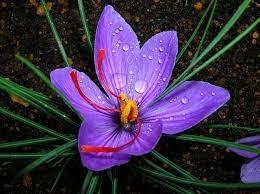There are many local legends about how saffron came to Kashmir. One goes back to the 12th century, and says that Sufi saints Khawaja Masood Wali and Sheikh Sharif-u-din Wali presented a local chieftain with a saffron bulb after he cured them of an illness while they were traveling. Another claims that the Persians brought it in 500 B.C., as a means to further trade and market. A third dates the spice back to the Hindu Tantric kings, when it was mixed into hot water to create potions that incited feelings of romantic love.
Kashmiri saffron is the sweetest, most precious spice in the world. Its strands are thicker and more fragrant than its counterpart from Iran, which accounts for more than 90 percent of the world’s saffron production. For Kashmiri farmers, crop sells for $1,550 a pound, in what was once a booming industry. Most of Kashmir’s saffron is grown in Pampore, south of the state’s summer capital, Srinagar. Thirty years ago, it would take Fehmida Mir’s family six to seven months to pick and then package their crop; she recounts memories of winters filled with the spice’s fragrance and palms golden from working with it. As recently as a decade ago, Mir would be able to harvest 200 kilograms of saffron, half of the 400 kilos her parents would get in the 1990s. Three years ago, her crop dropped to 20 kilograms; in 2016, it dropped to 15. Last year, the crop weighed less than 7 kilograms; this year’s produce has been the same. In all of Pampore, farmers have suffered similar fates, unable to account for their production for the last two years, as it was so little.
In other words, saffron production in Kashmir is at one of the lowest recorded in history.
In the Indian subcontinent, saffron has many names: zafran in Urdu (from Persian), kesar in Hindi, Kong Posh in Kashmiri, and kungumapoo in Tamil. It was popularized by the Mughals — the Turkic kings from Central Asia that made the subcontinent their home in the 16th century, who took saffron wherever they established court and introduced it into their cuisine. Under the Mughals, saffron, as a color and scent, became commonplace in the royal kitchens. It became prominent in biryani, in which golden-colored rice stacked with meat became a favorite meal. It was used in stews made with lamb; in breads like sheermal, a sweet, thick flatbread dipped in saffron water that is today eaten in Lucknow, an ex-Mughal capital in India’s North; in fruit sherbets as a cure from tiredness; and in phirni, a rice pudding made with spices and eaten all over Delhi, Lucknow, and other parts of India and Pakistan where the Mughals had established rule.

Mellow Yellow
More precious than goldhand-picked golden strands,
spice of the senses
yielded by the crocus
with mysterious power
that brings romantic love
to Mughals and Kings
colour that excites the palate
in biryani and sheermal
growing more rare
as conflict rages
and drought scorches soil
red-gold turn to grey
we seek you out
our pockets emptied
to savour your mysteryThank you for reading. Adele Email ThisBlogThis!Share to TwitterShare to Facebook
